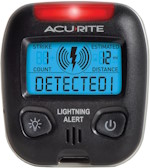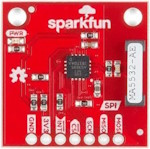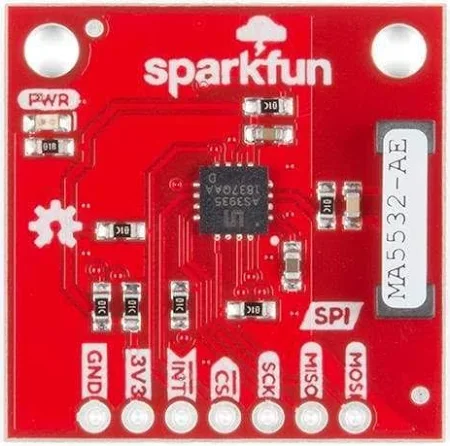Detection
Due to the danger lightning presents to people, animals, buildings, aeroplanes and other structures it is very useful to be able to detect the potential for thunderstorms in a location.
Origionaly the direction to the storm was determined magnetically but the most accurate systems employ a technique called time of arrival.
Commercial Detectors
 These range from a simple detectors such as the Acurite hand held detector. A detector such as this is ideal for outdoor events in areas where the possibility of a thunderstorm is high. Such activities include sports on outdoor fields, golf courses, rock climbing and fell walking.
These range from a simple detectors such as the Acurite hand held detector. A detector such as this is ideal for outdoor events in areas where the possibility of a thunderstorm is high. Such activities include sports on outdoor fields, golf courses, rock climbing and fell walking. This is obviously not a comprehensive list of situations but serves to give an idea of when such a safety device is appropriate.
For a better identification of thunderstorms comprehensive dectectors are available including the popular Boltec models.

A few personal weather stations now have either built in or an optional sensor for the recording of lightning. The Ecowitt weather station here at Maghull Weather has the optional lightning sensor located as clear of sources of interference as possible.
The ecowitt model employs the AS3935 detector chip and displays in the Ecowitt app and the console the current situation. The logging software, Weather Display, used at this site also records and keeps historical logs. Using the emailing facility it can notify of impending storms.
Kit Form
Blitzortung
The aim of the Blitzortung project is to accomplish a low budget highly accurate world-wide lightning location network based on a high number of receiver sites spaced close to each other, typically separated by 50 km - 250 km. The stations transmit their data to a central computing server, where the strike locations are computed by the arrival times of the signals.
The station operators are volunteers who bought and assembled the hardware by themselves. There are also volunteer programmers who develop and/or implement algorithms for the location or visualization of sferic positions, and people who assist to keep the system running.
DIY Detector
This new lightning detector circuit uses a single inductor tuned circuit to receive static pulses from lightning at a frequency near 200 kHz. The need for a tapped tuned circuit is eliminated by employing a very high input impedance RF amplifier that uses a darlington transistor. The amplifier is micro-power and the whole circuit draws only about 200 uA from two alkaline D cells, hardly denting the shelf life. The flasher portion of the circuit is similar to the earlier versions only the polarity of the transistors is reversed. As a result the output pulses momentarily go to ground from a normally-high state.
This DIY lightning detector circuit is a very sensitive static electricity detector that can provide an early warning of approaching storms from inter-cloud discharge well before an earth-to-sky return strike takes place. An aerial (antenna) formed of a short length of wire detects storms within a two mile radius.
All of the circuits that produce a sound from a buzzer or similar sounder can be modified to give a pulse for a weather station. to do further processing.
Silicon Chip
The AS3935 integrated circuit chip is the first integrated circuit lightning detector. The datasheet gives a comprehensive description of how the chip works.
>r
 />
/>The AS3935 is a programmable fully integrated Lightning Sensor IC that detects the presence and approach of potentially hazardous lightning activity in the vicinity and provides an estimation on the distance to the head of the storm.

The embedded lightning algorithm checks the incoming signal pattern to reject the potential man-made disturbers. The AS3935 can also provide information on the noise level and inform the external unit (e.g. microcontroller) in case of high noise conditions, with the noise floor generator and noise floor evaluation.
Sparkfun produce a circuit board with everything all on ready for detection and monitoring by a microcontroller or similar.
The data on this site is for information only as accuracy cannot be guaranteed.
It is not to be used where life or limb may be compromised.
Weather Warnings
It is not to be used where life or limb may be compromised.
Weather Warnings